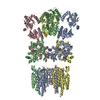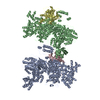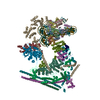+ Open data
Open data
- Basic information
Basic information
| Entry | Database: EMDB / ID: EMD-9894 | |||||||||
|---|---|---|---|---|---|---|---|---|---|---|
| Title | Tel1 compact asymmetric dimer | |||||||||
 Map data Map data | ||||||||||
 Sample Sample |
| |||||||||
| Biological species |  | |||||||||
| Method | single particle reconstruction / cryo EM / Resolution: 4.3 Å | |||||||||
 Authors Authors | Xin J | |||||||||
 Citation Citation |  Journal: Cell Res / Year: 2019 Journal: Cell Res / Year: 2019Title: Structural basis of allosteric regulation of Tel1/ATM kinase. Authors: Jiyu Xin / Zhu Xu / Xuejuan Wang / Yanhua Tian / Zhihui Zhang / Gang Cai /  Abstract: ATM/Tel1 is an apical kinase that orchestrates the multifaceted DNA damage response. Mutations of ATM/Tel1 are associated with ataxia telangiectasia syndrome. Here, we report cryo-EM structures of ...ATM/Tel1 is an apical kinase that orchestrates the multifaceted DNA damage response. Mutations of ATM/Tel1 are associated with ataxia telangiectasia syndrome. Here, we report cryo-EM structures of symmetric dimer (4.1 Å) and asymmetric dimer (4.3 Å) of Saccharomyces cerevisiae Tel1. In the symmetric state, the side chains in Tel1 C-terminus (residues 1129-2787) are discernible and an atomic model is built. The substrate binding groove is completely embedded in the symmetric dimer by the intramolecular PRD and intermolecular LID domains. Point mutations in these domains sensitize the S. cerevisiae cells to DNA damage agents and hinder Tel1 activation due to reduced binding affinity for its activator Xrs2/Nbs1. In the asymmetric state, one monomer becomes more compact in two ways: the kinase N-lobe moves down and the Spiral of α-solenoid moves upwards, which resemble the conformational changes observed in active mTOR. The accessibility of the activation loop correlates with the synergistic conformational disorders in the TRD1-TRD2 linker, FATC and PRD domains, where critical post-translational modifications and activating mutations are coincidently condensed. This study reveals a tunable allosteric network in ATM/Tel1, which is important for substrate recognition, recruitment and efficient phosphorylation. | |||||||||
| History |
|
- Structure visualization
Structure visualization
| Movie |
 Movie viewer Movie viewer |
|---|---|
| Structure viewer | EM map:  SurfView SurfView Molmil Molmil Jmol/JSmol Jmol/JSmol |
| Supplemental images |
- Downloads & links
Downloads & links
-EMDB archive
| Map data |  emd_9894.map.gz emd_9894.map.gz | 59.7 MB |  EMDB map data format EMDB map data format | |
|---|---|---|---|---|
| Header (meta data) |  emd-9894-v30.xml emd-9894-v30.xml emd-9894.xml emd-9894.xml | 7.1 KB 7.1 KB | Display Display |  EMDB header EMDB header |
| Images |  emd_9894.png emd_9894.png | 169.5 KB | ||
| Archive directory |  http://ftp.pdbj.org/pub/emdb/structures/EMD-9894 http://ftp.pdbj.org/pub/emdb/structures/EMD-9894 ftp://ftp.pdbj.org/pub/emdb/structures/EMD-9894 ftp://ftp.pdbj.org/pub/emdb/structures/EMD-9894 | HTTPS FTP |
-Validation report
| Summary document |  emd_9894_validation.pdf.gz emd_9894_validation.pdf.gz | 78.2 KB | Display |  EMDB validaton report EMDB validaton report |
|---|---|---|---|---|
| Full document |  emd_9894_full_validation.pdf.gz emd_9894_full_validation.pdf.gz | 77.3 KB | Display | |
| Data in XML |  emd_9894_validation.xml.gz emd_9894_validation.xml.gz | 493 B | Display | |
| Arichive directory |  https://ftp.pdbj.org/pub/emdb/validation_reports/EMD-9894 https://ftp.pdbj.org/pub/emdb/validation_reports/EMD-9894 ftp://ftp.pdbj.org/pub/emdb/validation_reports/EMD-9894 ftp://ftp.pdbj.org/pub/emdb/validation_reports/EMD-9894 | HTTPS FTP |
-Related structure data
- Links
Links
| EMDB pages |  EMDB (EBI/PDBe) / EMDB (EBI/PDBe) /  EMDataResource EMDataResource |
|---|
- Map
Map
| File |  Download / File: emd_9894.map.gz / Format: CCP4 / Size: 64 MB / Type: IMAGE STORED AS FLOATING POINT NUMBER (4 BYTES) Download / File: emd_9894.map.gz / Format: CCP4 / Size: 64 MB / Type: IMAGE STORED AS FLOATING POINT NUMBER (4 BYTES) | ||||||||||||||||||||||||||||||||||||||||||||||||||||||||||||
|---|---|---|---|---|---|---|---|---|---|---|---|---|---|---|---|---|---|---|---|---|---|---|---|---|---|---|---|---|---|---|---|---|---|---|---|---|---|---|---|---|---|---|---|---|---|---|---|---|---|---|---|---|---|---|---|---|---|---|---|---|---|
| Projections & slices | Image control
Images are generated by Spider. | ||||||||||||||||||||||||||||||||||||||||||||||||||||||||||||
| Voxel size | X=Y=Z: 1.35 Å | ||||||||||||||||||||||||||||||||||||||||||||||||||||||||||||
| Density |
| ||||||||||||||||||||||||||||||||||||||||||||||||||||||||||||
| Symmetry | Space group: 1 | ||||||||||||||||||||||||||||||||||||||||||||||||||||||||||||
| Details | EMDB XML:
CCP4 map header:
| ||||||||||||||||||||||||||||||||||||||||||||||||||||||||||||
-Supplemental data
- Sample components
Sample components
-Entire : Tel1 kinase compact dimer
| Entire | Name: Tel1 kinase compact dimer |
|---|---|
| Components |
|
-Supramolecule #1: Tel1 kinase compact dimer
| Supramolecule | Name: Tel1 kinase compact dimer / type: organelle_or_cellular_component / ID: 1 / Parent: 0 / Macromolecule list: #1 |
|---|---|
| Source (natural) | Organism:  |
-Experimental details
-Structure determination
| Method | cryo EM |
|---|---|
 Processing Processing | single particle reconstruction |
| Aggregation state | particle |
- Sample preparation
Sample preparation
| Buffer | pH: 8 |
|---|---|
| Vitrification | Cryogen name: ETHANE |
- Electron microscopy
Electron microscopy
| Microscope | FEI TITAN KRIOS |
|---|---|
| Image recording | Film or detector model: GATAN K2 SUMMIT (4k x 4k) / Average electron dose: 50.0 e/Å2 |
| Electron beam | Acceleration voltage: 300 kV / Electron source:  FIELD EMISSION GUN FIELD EMISSION GUN |
| Electron optics | Illumination mode: FLOOD BEAM / Imaging mode: BRIGHT FIELD |
| Experimental equipment |  Model: Titan Krios / Image courtesy: FEI Company |
- Image processing
Image processing
| Final reconstruction | Resolution.type: BY AUTHOR / Resolution: 4.3 Å / Resolution method: FSC 0.143 CUT-OFF / Number images used: 51010 |
|---|---|
| Initial angle assignment | Type: PROJECTION MATCHING |
| Final angle assignment | Type: PROJECTION MATCHING |
 Movie
Movie Controller
Controller














 Z (Sec.)
Z (Sec.) Y (Row.)
Y (Row.) X (Col.)
X (Col.)





















